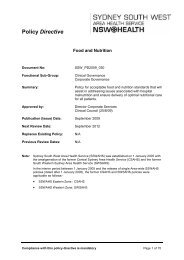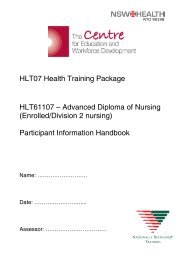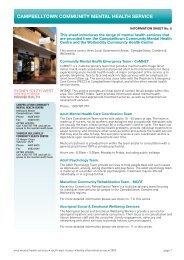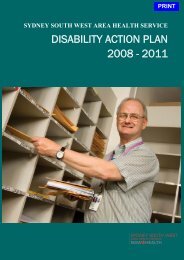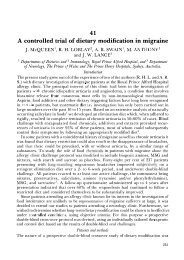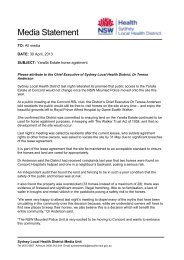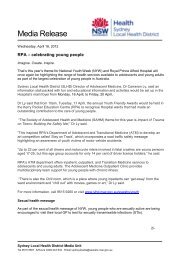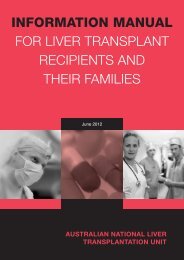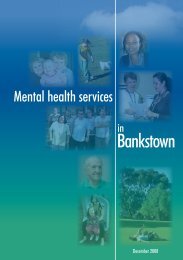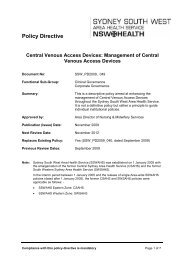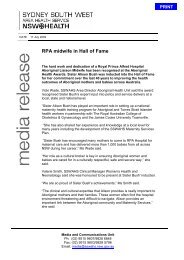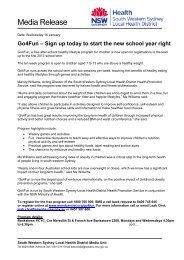Child Related Allegations, Charges and Convictions Against ...
Child Related Allegations, Charges and Convictions Against ...
Child Related Allegations, Charges and Convictions Against ...
Create successful ePaper yourself
Turn your PDF publications into a flip-book with our unique Google optimized e-Paper software.
Policy Directive<strong>Child</strong> <strong>Related</strong> <strong>Allegations</strong>, <strong>Charges</strong> <strong>and</strong> <strong>Convictions</strong><strong>Against</strong> EmployeesDocument No:Functional Sub-Group:Summary:SSW_PD2010_018Corporate GovernanceSydney South West Area Health Service (SSWAHS) iscommitted to protecting the safety, welfare <strong>and</strong> wellbeingof children.The SSWAHS policy directive sets out guidelines to assiststaff comply with obligations under NSW HealthPD2006_025 <strong>Child</strong> <strong>Related</strong> <strong>Allegations</strong>, <strong>Charges</strong> <strong>and</strong><strong>Convictions</strong> <strong>Against</strong> Employees (attached).SSWAHS employees who become aware of any childrelated allegation, charge or conviction against anotherSSWAHS employee (or about themselves) mustimmediately report the matter to one of the designatedstaff listed in section 1 of these guidelines.Approved by:Publication (Issue) Date:Chief Executive, SSWAHSDirector Corporate Services, Governance <strong>and</strong> Risk,SSWAHS21 April 2006 (NSW Health PD2006_025)Next Review Date: April 2011Replaces Existing Policy:Previous Review Dates:N/AN/ANote:Sydney South West Area Health Service (SSWAHS) was established on 1 January 2005 withthe amalgamation of the former Central Sydney Area Health Service (CSAHS) <strong>and</strong> the formerSouth Western Sydney Area Health Service (SWSAHS).In the interim period between 1 January 2005 <strong>and</strong> the release of single Area-wide SSWAHSpolicies (dated after 1 January 2005), the former CSAHS <strong>and</strong> SWSAHS policies wereapplicable as follows:-• SSWAHS Eastern Zone : CSAHS• SSWAHS Western Zone: SWSAHS
Policy DirectiveDepartment of Health, NSW73 Miller Street North Sydney NSW 2060Locked Mail Bag 961 North Sydney NSW 2059Telephone (02) 9391 9000 Fax (02) 9391 9101http://www.health.nsw.gov.au/policies/<strong>Child</strong> <strong>Related</strong> <strong>Allegations</strong>, <strong>Charges</strong> <strong>and</strong> <strong>Convictions</strong> <strong>Against</strong>EmployeesDocument Number PD2006_025Publication date 21-Apr-2006Functional Sub group Personnel/Workforce - Industrial <strong>and</strong> Employee RelationsPersonnel/Workforce - Conduct <strong>and</strong> ethicsPersonnel/Workforce - Employment ScreeningspacespacespaceSummary This policy directive sets out the m<strong>and</strong>atory requirements for respondingto any allegation, charge or conviction against a NSW Health employeewhere it involves children. The policy includes the m<strong>and</strong>atoryresponsibilities to be complied with by health services for themanagement of reportable (child-related) allegations <strong>and</strong> convictionsagainst employees.Replaces Doc. No. <strong>Child</strong> Abuse <strong>Allegations</strong> - Ombudsman Amendment (<strong>Child</strong> Protection <strong>and</strong>Community Services) Act 1998 [PD2005_574]Author Branch Corporate Governance <strong>and</strong> Risk ManagementBranch contact Andrew Graham 9391 9394Applies to Area Health Services/Chief Executive Governed Statutory HealthCorporation, Board Governed Statutory Health Corporations, AffiliatedHealth Organisations, Public Health System Support Division, CommunityHealth Centres, Dental Schools <strong>and</strong> Clinics, NSW Ambulance Service,NSW Dept of Health, Public Health Units, Public HospitalsAudience All staffDistributed to Public Health System, Community Health Centres, Dental Schools <strong>and</strong>Clinics, Health Associations Unions, NSW Ambulance Service, NSWDepartment of Health, Public Health Units, Public HospitalsReview date 21-Apr-2011File No. 05/6783Status ActiveDirector-GeneralspaceCompliance with this policy directive is m<strong>and</strong>atory.
CHILD RELATED ALLEGATIONS, CHARGES ANDCONVICTIONS AGAINST EMPLOYEES.April 2006
Policy DirectiveTitle: <strong>Child</strong> related allegations, charges <strong>and</strong> convictions.Table of Contents1 Introduction .....................................................................................................................21.1 Purpose <strong>and</strong> scope of the Policy Directive ................................................................21.2 <strong>Related</strong> NSW Health Policy Directives ......................................................................22 Glossary...........................................................................................................................33 Overview of legislation ...................................................................................................63.1 Ombudsman Act 1974 <strong>and</strong> Ombudsman Regulation 2005 .......................................63.2 Commission for <strong>Child</strong>ren <strong>and</strong> Young People Act 1998 <strong>and</strong> Commission for <strong>Child</strong>ren<strong>and</strong> Young People Regulation 2000.......................................................................63.3 <strong>Child</strong> Protection (Prohibited Employment) Act 1998 .................................................73.4 <strong>Child</strong>ren <strong>and</strong> Young Persons (Care <strong>and</strong> Protection) Act 1998 ..................................74 Chief Executive <strong>and</strong> employee responsibilities ...........................................................84.1 Employee responsibilities ..........................................................................................84.2 Chief Executive responsibilities .................................................................................84.2.1 Notifying the Ombudsman of reportable allegations <strong>and</strong> convictions .........94.2.2 Responding to reportable allegations <strong>and</strong> convictions ...............................95 Procedure for responding to child-related allegations, charges <strong>and</strong> convictions .115.1 Recording the details of a child-related allegation or conviction..............................125.2 Considering risk of harm to a child or class of children ...........................................125.3 Notifying the Chief Executive or ESRU/the Ombudsman........................................135.4 Assessing the risk to patients, clients <strong>and</strong> employees ............................................135.5 Notifying appropriate bodies....................................................................................146 Investigating an allegation of reportable conduct .....................................................166.1 Objectives of an investigation into a reportable allegation ......................................166.2 Appointing an Investigator .......................................................................................176.3 Informing the employee ...........................................................................................176.4 Investigation Length ................................................................................................186.5 Concluding the investigation <strong>and</strong> taking disciplinary action.....................................186.5.1 <strong>Child</strong> Protection (Prohibited Employment) Act 1998.................................196.6 Notifying the Ombudsman following investigation into reportable allegations orconvictions............................................................................................................206.7 Notifying CCYP of prohibited employment <strong>and</strong> completed relevant employmentproceedings ..........................................................................................................216.7.1 Prohibited employment .............................................................................216.7.2 Completed relevant employment proceedings .........................................217 Keeping Records...........................................................................................................228 Contact information ......................................................................................................239 List of Attachments.......................................................................................................249.1 Ombudsman Notification Form9.2 Relevant Employment Proceedings Notification Form9.3 Responding to <strong>Allegations</strong> involving children flowchartpage 1 of 24
Policy DirectiveTitle: <strong>Child</strong> related allegations, charges <strong>and</strong> convictions.1 Introduction1.1 Purpose <strong>and</strong> scope of the Policy DirectiveThis Policy Directive applies to the Department of Health, Area Health Services,Statutory Health Corporations, declared <strong>and</strong> non-declared Affiliated HealthOrganisations, <strong>and</strong> the Ambulance Service of NSW, collectively referred to as“Health Services” for the purposes of this Directive.A child-related allegation is an allegation that something has happened to a child orin the presence of a child.The Directive outlines requirements for h<strong>and</strong>ling <strong>and</strong> responding to child-relatedallegations, charges <strong>and</strong> convictions made against persons working in HealthServices (including contractors, sub-contractors, volunteers <strong>and</strong> trainees) <strong>and</strong>employees of the Government of New South Wales (NSW Health Service) for whomHealth Services have delegated employment responsibilities, collectively referred toas “employees” for the purposes of this Directive.1.2 <strong>Related</strong> NSW Health Policy DirectivesIn cases where criminal conduct is alleged or established but does not concernpersons under 18 years old at the time of the alleged conduct, the NSW HealthPolicy Directive PD2006_026 Criminal <strong>Allegations</strong>, <strong>Charges</strong> <strong>and</strong> <strong>Convictions</strong>, shouldbe followed.Where a Health Service employee reasonably believes that a child or children are atrisk of harm, NSW Health Policy Directive 2005-299, Protecting <strong>Child</strong>ren <strong>and</strong> YoungPeople, should also be read <strong>and</strong> applied in conjunction with this Directive.NSW Health Policy Directive PD2005_632 Communications Systems: Use of NSWHealth Communication Systems provides that any person facing disciplinaryproceedings involving the use of NSW Health communication systems <strong>and</strong> devices toproduce, disseminate or possess child pornography should be suspended from dutyuntil those disciplinary proceedings are finalised.Where an allegation involves the conduct of a health practitioner or health serviceprovider, the NSW Health Policy Directive concerning the management of acomplaint or concern about a clinician (Complaint or concern about a clinician –principles for action PD2005_007) should be consulted <strong>and</strong> appropriate actionshould be taken to inform registration authorities <strong>and</strong> other bodies, as relevant.This Policy Directive should also be read in conjunction with relevant PolicyDirectives concerning employment screening (PD2005_177, PD2005_193 <strong>and</strong>PD2005_196).page 2 of 24
Policy DirectiveTitle: <strong>Child</strong> related allegations, charges <strong>and</strong> convictions.2 GlossaryThe following are definitions for some terms used in this Directive:CCYP: Commission for <strong>Child</strong>ren <strong>and</strong> Young People.Chief Executive: The principal officer of a Health Service.<strong>Child</strong>: A person under the age of 18. (Ombudsman Act 1974, Section 25A(1))<strong>Child</strong>-related employment: Employment of the following kind [selected withpossible relevance to Health Services] that primarily involves direct contact withchildren where that contact is not directly supervised:• Employment in wards of public or private hospitals in which children arepatients;• Employment involving the direct provision of child health services;• Employment involving the provision of counselling or other support servicesto children;• Employment in detention centres (within the meaning of the <strong>Child</strong>ren(Detention Centres) Act 1987);• Employment in schools or other educational institutions (not beinguniversities);• Employment in pre-schools, kindergartens <strong>and</strong> child care centres (includingresidential child care centres);• Employment in refuges used by children;• Employment at overnight camps for children;• Employment involving the provision of child protection services;• Employment in entertainment venues where the clientele is primarilychildren. (<strong>Child</strong> Protection (Prohibited Employment) Act 1998, Section 3)Employee 1 : A person engaged in employment by or in connection with a HealthService.Employment: Employment means:• Performance of work under a contract of employment or as the holder of aremunerated position;• Performance of work as a self-employed person or as a sub-contractor;• Performance of work as a volunteer for an organisation;• Undertaking practical training as part of an educational or vocational course;or• Performance of work as a minister of religion or other member of a religiousorganisation. (Commission for <strong>Child</strong>ren <strong>and</strong> Young People Act 1998, Section33(1))Employment Screening <strong>and</strong> Review Unit (ESRU): The Unit within theDepartment of Health that provides Health Services with advice <strong>and</strong> support in1 Whilst s25A(1) of the Ombudsman Act 1974 restricts the definition of employee to personssubject to a contract of employment, <strong>and</strong> other persons engaged to provide services tochildren (including in the capacity of a volunteer), it is NSW Health policy that employee isdefined with reference to the broader definition of employment used in this Directive inreporting matters to the Ombudsman under Part 3A of the Ombudsman Act.page 3 of 24
Policy DirectiveTitle: <strong>Child</strong> related allegations, charges <strong>and</strong> convictions.responding to child-related <strong>and</strong> criminal allegations, charges <strong>and</strong> convictions, <strong>and</strong>which monitors performance in responding to such matters. The Unit alsocoordinates employment screening for the NSW Health system.Grooming Behaviour: Involves a pattern of behaviour aimed at engaging a child asa precursor to sexual abuse. The grooming process can include:• Persuading the child that a “special” relationship exists – spendinginappropriate special time with the child, inappropriately giving gifts, showingspecial favours to them but not other children, allowing the child to oversteprules etc.;• Testing of boundaries – undressing in front of the child, allowing the child tosit on the lap, talking about sex, ‘accidental’ touching of genitals etc.These behaviours may not indicate risk if occurring in isolation but if there is apattern of behaviour occurring, it may indicate grooming.Health Service: The Department of Health, Area Health Services, Statutory HealthCorporations, declared <strong>and</strong> non-declared Affiliated Health Organisations, <strong>and</strong> theAmbulance Service of NSW.Ombudsman: An independent review body, whose primary role is to promote goodconduct <strong>and</strong> fair decision-making in the interests of the NSW community. TheOmbudsman also has a child protection responsibility to ensure that reportableallegations <strong>and</strong> convictions against employees are effectively <strong>and</strong> fairly investigated<strong>and</strong> that any risk posed by those employees is properly assessed <strong>and</strong> managed.Procedural Fairness: In terms of investigations <strong>and</strong> risk assessments, proceduralfairness involves informing the employee of the substance, with as much detail aspossible, of the allegation made against them; providing the employee opportunity toput forward their case; making reasonable inquiries during the investigation stage;considering all relevant evidence, ensuring that there is no conflict of interest; actingfairly <strong>and</strong> without bias; conducting investigations <strong>and</strong> risk assessments withoutundue delay; <strong>and</strong>, maintaining good records in relation to these matters.Relevant employment proceedings: Disciplinary proceedings (in NSW orelsewhere) against an employee by the employer or by a professional or other bodythat supervises the professional conduct of the employee, being proceedingsinvolving:(a) Reportable conduct by the employee, or(b) An act of violence committed by the employee in the course of employment<strong>and</strong> in the presence of a child,Unless there is a finding that the allegation in such proceedings was not reportableconduct, was false, was vexatious, or was misconceived (Commission for <strong>Child</strong>ren<strong>and</strong> Young People Act 1998, Section 33(1) <strong>and</strong> Section 39(1) – Commission for<strong>Child</strong>ren <strong>and</strong> Young People Regulation 2000, Clause 8).Reportable allegation: An allegation of reportable conduct against a person or anallegation of misconduct that may involve reportable conduct (Ombudsman Act,Section 25A.)A reportable allegation includes a charge for an offence involving reportableconduct, where there has been no conviction in respect of that charge.page 4 of 24
Policy DirectiveTitle: <strong>Child</strong> related allegations, charges <strong>and</strong> convictions.Reportable Conduct (Ombudsman Act, section 25A(1)):a) Any sexual offence, or sexual misconduct, committed against, with or in thepresence of a child (including a child pornography offence); orb) Any assault, ill treatment or neglect of a child; orc) Any behaviour that causes psychological harm to a child,Whether or not, in any case, with the consent of the child.Reportable conduct does not extend to:a) Conduct that is reasonable for the purposes of the discipline, managementor care of children, having regard to the age, maturity, health or othercharacteristics of the children <strong>and</strong> to any relevant codes of conduct orprofessional st<strong>and</strong>ards, orb) The use of physical force that, in all the circumstances, is trivial ornegligible, but only if the matter is to be investigated <strong>and</strong> the result of theinvestigation recorded under workplace employment procedures, orc) Conduct of a class or kind exempted from being reportable conduct by theOmbudsman under section 25CA of the Ombudsman Act 1974.Reportable conviction: A conviction (including a finding of guilt without the courtproceeding to a conviction), in NSW or elsewhere, of an offence involving reportableconduct (Ombudsman Act 1974, Section 25A(1))Sexual misconduct (as it applies to children): Describes a range of behaviours ora pattern of behaviour aimed at the involvement of children in sexual acts. Some ofthese behaviours may include:• Inappropriate conversations of a sexual nature;• Comments that express a desire to act in a sexual manner;• Unwarranted <strong>and</strong> inappropriate touching;• Sexual exhibitionism;• Personal correspondence (including electronic communication) with a childor young person in respect of the adult’s sexual feelings for a child or youngperson;• Deliberate exposure of children <strong>and</strong> young people to sexual behaviour ofothers, including the display of pornography.Sexual misconduct includes ‘grooming behaviour’ (see separate definition).Support Person: A person nominated by an employee to support them during anyinvestigation or inquiry into the employee. The support person’s role is to offersupport to the employee <strong>and</strong> does not include direct involvement in the investigationor inquiry, other than when the employee requests the support person attendmeetings <strong>and</strong> interviews. The support person in these circumstances may advisethe employee in respect to answering questions <strong>and</strong> discussing issues, howevermay not interrupt or bring into consideration issues on behalf of the employee.Where an employee has limited communication skills, the support person may benominated to talk on the employee’s behalf.page 5 of 24
Policy DirectiveTitle: <strong>Child</strong> related allegations, charges <strong>and</strong> convictions.3 Overview of legislation3.1 Ombudsman Act 1974 <strong>and</strong> Ombudsman Regulation 2005Part 3A of the Ombudsman Act 1974 <strong>and</strong> the Ombudsman Regulation 2005 requireHealth Services to notify the Ombudsman of allegations (including charges) <strong>and</strong>convictions against employees that involve or may involve “reportable conduct” -that is, allegations or convictions of conduct that may constitute:• A sexual offence, or sexual misconduct, committed against, with or in thepresence of a child (including a child pornography offence);• Assault, ill treatment or neglect of a child; or• Behaviour that causes psychological harm to a child,subject to the exceptions identified in the definition of “reportable conduct” in theGlossary to this Directive.This extends to allegations <strong>and</strong> convictions for conduct or alleged conduct thatoccurred outside the course of, or prior to, the employee’s employment with a HealthService.The Act also requires Health Services to inform the Ombudsman of the results ofinvestigations into reportable allegations <strong>and</strong> convictions <strong>and</strong> the action taken, orproposed to be taken, in response to such an allegation or conviction.Under the Act, the Chief Executive is required to establish policies <strong>and</strong> proceduresfor preventing reportable conduct by employees, <strong>and</strong> for responding to allegations<strong>and</strong> convictions involving reportable conduct by employees.Chief Executives must also ensure that employees are informed of their obligation tonotify the Chief Executive when they become aware of any reportable allegation orconviction, <strong>and</strong> that there are clear internal reporting lines to facilitate this.3.2 Commission for <strong>Child</strong>ren <strong>and</strong> Young People Act 1998 <strong>and</strong> Commission for<strong>Child</strong>ren <strong>and</strong> Young People Regulation 2000The Commission for <strong>Child</strong>ren <strong>and</strong> Young People Act 1998 <strong>and</strong> Regulation, <strong>and</strong>NSW Health delegations, require Health Services to notify CCYP of relevantemployment proceedings, being disciplinary proceedings against an employee bythe employer or by a professional or other body that supervises the professionalconduct of the employee, involving:(a) Reportable conduct by the employee, or(b) An act of violence committed by the employee in the course ofemployment <strong>and</strong> in the presence of a child,unless there is a finding that reportable conduct did not occur or the allegation wasfalse, vexatious, or misconceived.Matters where there is some evidence that reportable conduct has occurred but thefinding is inconclusive, or that are not sustained because of insufficient evidence,must also be reported to CCYP.Relevant employment proceedings include proceedings that have been completedthrough the actions of the employee, for example where the employee resignsbefore the disciplinary investigation is finalised.page 6 of 24
Policy DirectiveTitle: <strong>Child</strong> related allegations, charges <strong>and</strong> convictions.3.3 <strong>Child</strong> Protection (Prohibited Employment) Act 1998The Act makes it an offence for a person who has been convicted of a serious sexoffence, or a person who is a registrable person within the meaning of the <strong>Child</strong>Protection (Offenders Registration) Act 2000, to apply for, undertake or remain inchild-related employment, unless CCYP, the Industrial Relations Commission or theAdministrative Decisions Tribunal has made an order (which may be subject toconditions) that the Act does not apply to the person.Persons who cannot lawfully work in child-related employment are known as“prohibited persons”.The Act also makes it an offence for an employer to commence employing, orcontinue to employ, a person that the employer knows to be a prohibited person inchild-related employment.This means that the Act will need to be considered in determining appropriateaction in response to some reportable convictions.3.4 <strong>Child</strong>ren <strong>and</strong> Young Persons (Care <strong>and</strong> Protection) Act 1998The Act focuses on children <strong>and</strong> young persons at ‘risk of harm’ <strong>and</strong> prescribes therole of the Department of Community Services (DoCS) <strong>and</strong> the role of families,agencies <strong>and</strong> communities in relation to child protection.Under the Act <strong>and</strong> ministerial directives, Health Service employees must report tothe DoCS ‘helpline’ any reasonable belief that a person or class of persons underthe age of 16 is ‘at risk of harm’.The Act also enables Health Service employees to report to DoCS a reasonablebelief that a young person (child aged 16 or 17) or class of young persons is at riskof harm.NSW Health Policy Directive 2005-299 Protecting <strong>Child</strong>ren <strong>and</strong> Young People,outlines the responsibilities of Health Services <strong>and</strong> Health Service employees underthe Act <strong>and</strong> in protecting <strong>and</strong> supporting children.page 7 of 24
Policy DirectiveTitle: <strong>Child</strong> related allegations, charges <strong>and</strong> convictions.4 Chief Executive <strong>and</strong> employee responsibilities4.1 Employee responsibilitiesEmployees who become aware of a child-related allegation, charge or convictionagainst another employee of their Health Service must report that matter to theirsupervisor or the designated person within their Health Service.In accordance with the NSW Health Code of Conduct, employees must also reportto their supervisor or the designated person within their Health Service anybehaviour or circumstances that lead them to suspect another employee hasengaged in reportable conduct.Where an employee becomes aware of a child-related allegation, charge orconviction concerning the employee of another Health Service, or the ChiefExecutive or senior member of staff of their Health Service, these matters must bereported to ESRU <strong>and</strong> may also be reported to the Ombudsman.Under the Public Sector Employment <strong>and</strong> Management (General) Regulation 1996an officer of the Department of Health who is charged with having committed, or isconvicted of, a serious offence is required to immediately report that fact to theDirector-General (clause 100A). A serious offence is an offence that may bepunishable by imprisonment for 12 months or more.Under the Health Services Act 1997, a member of the NSW Health Service or avisiting practitioner of a Health Service who is charged with having committed, or isconvicted of, a serious sex or violence offence, must report the fact in writing to theChief Executive of the Health Service within 7 days of the charge or conviction.Serious sex or violence offences are offences committed in any jurisdiction thatinvolve sexual activity, acts of indecency, physical violence or the threat of physicalviolence that, if they were or if they had been committed in NSW, may be punishableby imprisonment for 12 months or more.In accordance with the NSW Health Code of Conduct, all employees are required toreport to their Chief Executive any charges brought against them relating to theproduction, dissemination or possession of child pornography.4.2 Chief Executive responsibilitiesChief Executives must:• Have in place procedures for ensuring that all employees are madeaware of their responsibilities in responding to child- related allegations,charges or convictions;• Have in place procedures for Chief Executives to be notified of all childrelatedallegations, charges or convictions;• Identify persons responsible for conducting risk assessments <strong>and</strong>investigating such allegations, charges <strong>and</strong> convictions; <strong>and</strong>,• Ensure all appropriate bodies, such as Police, the Department ofCommunity Services <strong>and</strong> NSW Ombudsman are notified as relevant.page 8 of 24
Policy DirectiveTitle: <strong>Child</strong> related allegations, charges <strong>and</strong> convictions.4.2.1 Notifying the Ombudsman of reportable allegations <strong>and</strong> convictionsIn accordance with Part 3A of the Ombudsman Act 1974, Chief Executives of HealthServices must notify the NSW Ombudsman of the following:• Any reportable allegation, or reportable conviction, against an employee ofthe Health Service,• Whether or not the Health Service proposes to take any disciplinary or otheraction in relation to the employee <strong>and</strong> the reasons why it intends to take ornot to take any such action,• Any written submissions made to the Chief Executive concerning any suchallegation or conviction that the employee concerned wished to haveconsidered in determining what (if any) disciplinary or other action should betaken in relation to the allegation or conviction.The notification of a reportable allegation or reportable conviction must beundertaken as soon as practicable <strong>and</strong> must be made, in any event, within 30days of the Chief Executive becoming aware of the allegation or conviction (orwithin such further period as may be agreed to by the Ombudsman).Chief Executives must provide the Ombudsman with any documents or informationthe Ombudsman requests in respect to the Health Service’s h<strong>and</strong>ling of thereportable allegation or conviction, <strong>and</strong> must allow an officer of the Ombudsman toattend interviews or confer with the Health Service’s investigator, if requested.Upon being satisfied that the investigation into the reportable allegation or convictionis concluded, the Ombudsman Act also requires Chief Executives to, as soon aspracticable:• Send the Ombudsman a copy of any report prepared by or provided as to theprogress or results of the investigation, <strong>and</strong> copies of all statements taken inthe course of the investigation <strong>and</strong> of all other documents on which thereport is based, <strong>and</strong>• Provide the Ombudsman with such comments on the report <strong>and</strong> statementsas the Chief Executive thinks fit, <strong>and</strong>• Inform the Ombudsman of the action that has been taken or is proposed tobe taken with respect to the reportable allegation or conviction.4.2.2 Responding to reportable allegations <strong>and</strong> convictionsIn responding to reportable convictions or allegations of reportable conduct,irrespective of when <strong>and</strong> where the conduct occurred or allegedly occurred, ChiefExecutives must ensure that Health Services:• Conduct an immediate risk assessment to determine whether there is anyrisk of further or ongoing harm to the child <strong>and</strong> whether the employee subjectto the allegation or conviction requires relocation, supervision orsuspension 2 .• Notify NSW Police where an allegation involves possible criminal conduct.• Notify DoCS where there is a reasonable belief that a child or class ofchildren is at risk of harm.2 At any point during either a risk assessment or investigation where there is a reasonablebelief that conduct has occurred that would constitute a serious criminal offence, theemployee should be suspended pending investigation <strong>and</strong> a decision with respect todisciplinary action.page 9 of 24
Policy DirectiveTitle: <strong>Child</strong> related allegations, charges <strong>and</strong> convictions.• Submit a Reportable Incident Brief to the Director General within 24 hours ofthe Chief Executive becoming aware of the allegation or conviction.• Notify the Ombudsman in accordance with the Ombudsman Act 1974 <strong>and</strong>provide a copy of the formal notification to ESRU.• Ensure a suitably qualified person undertakes an investigation into thematter in a transparent, accountable <strong>and</strong> confidential manner.• Keep appropriate records of the investigation.• Provide copies of the final investigation report <strong>and</strong> other relevant material tothe Ombudsman <strong>and</strong> ESRU within 7 days of completion of the investigation.• Notify CCYP of any completed relevant employment proceedings.page 10 of 24
Policy DirectiveTitle: <strong>Child</strong> related allegations, charges <strong>and</strong> convictions.5 Procedure for responding to child-related allegations, charges <strong>and</strong>convictionsThe procedure for responding to child related allegations (including charges) <strong>and</strong> convictionsis depicted in Figure 1 below.Figure 1: Responding to allegations (including charges) <strong>and</strong> convictionsconcerning children.Health Service employee ismade aware of an allegation of,or conviction for, inappropriatechild related conduct.Employee records details ofallegation/conviction. Whathappened, when <strong>and</strong> where,who was involved.Is any child/children atrisk of harm?YNotify DoCS Helpline.Consult NSW HealthPolicy Directive 2005-299.NAt all stages in this process the NSWOmbudsman <strong>Child</strong> Protection Team (02Note if there is an9286 1000) <strong>and</strong> the NSW Health,immediate risk ofharm to anyone,Employment Screening <strong>and</strong> Review UnitNSW Police <strong>and</strong>(02 9391 9800) are available to provideSecurity should beadvice <strong>and</strong> assistance.contactedimmediatelyInvestigations should be conducted by anappropriately trained <strong>and</strong> experiencedinvestigations officer.NOTE: If the allegation isagainst an employee of anotherNotify Chief Executive (via Mgr).Health Service, a ChiefCE or delegate to notify Police ifExecutive or Senior Manager,criminal conduct alleged.ESRU should be notified.CE or delegate assesseswhether the employee shouldbe directly supervised, relocatedor suspended.Health Service initiatesinvestigation.The NSW Ombudsman Guide to<strong>Child</strong> Protection in theWorkplace should be consulted.Is allegation/convictionreportable under theOmbudsman Act 1974?NHealth service undertakesappropriate investigation <strong>and</strong>disciplinary action <strong>and</strong> recordsfindings.A Reportable Incident Brief mustbe submitted within 24 hours ofthe allegation being made.YReportable Incident Brief sent tothe Director-General.ESRU notified thatinvestigation has beenundertaken & concluded.The Ombudsman must benotified as soon as practicable<strong>and</strong> in any event within 30 daysof the allegation being made.Investigations <strong>and</strong> disciplinaryaction must be finalised in atimely mannerNSW Ombudsman notified usingOmbudsman notification form.ESRU provided a copy.Health Service completesinvestigation <strong>and</strong> determinesany disciplinary actionNOTE: Where an allegation/convictioninvolves an act of violence in thecourse of employment <strong>and</strong> in thepresence of a child, CCYP must benotified unless the finding is that theallegation was false, vexatious ormisconceived.Was the finding that theallegation was false, vexatious,misconceived or did not involvereportable conduct?YCCYP <strong>and</strong> Ombudsman must benotified within 7 days ofinvestigation being finalised.NNotify CCYP using the RelevantEmployment ProceedingsNotification Form. ESRUprovided a copy.Final Report <strong>and</strong> Part B ofOmbudsman notificationform sent to Ombudsman.ESRU provided a copy.page 11 of 24
Policy DirectiveTitle: <strong>Child</strong> related allegations, charges <strong>and</strong> convictions.Before an investigation is conducted, there are a number of steps that need to betaken in order to protect the interests of the child <strong>and</strong> the employee.5.1 Recording the details of a child-related allegation or convictionWhere the allegation has not been received in writing, the allegation should berecorded to clarify what is being alleged. The words used by the person making theallegation must be recorded word for word, if possible, <strong>and</strong> clarified with the personmaking the verbal allegation.If it is necessary to seek clarification of a verbal allegation, ensure that the personmaking the allegation explains events in their own words. Asking leading questions(eg: Did he touch you there?) may compromise future criminal investigations.Details of any information received about a child-related charge or conviction shouldalso be recorded.5.2 Considering risk of harm to a child or class of childrenNSW Health Policy Directive 2005-299 Protecting <strong>Child</strong>ren <strong>and</strong> Young Peoplerequires Health Service employees to report to the DoCS ‘helpline’ any reasonablebelief that a person or class of persons under the age of 16 is ‘at risk of harm’.Under that Directive <strong>and</strong> section 24 of the <strong>Child</strong>ren <strong>and</strong> Young Persons (Care <strong>and</strong>Protection) Act 1998, a Health Service employee may also report concerns aboutrisk of harm to a person aged 16 or 17 (a young person) or class of young persons.Where a Health Service employee is concerned that a young person or class ofyoung persons is at risk of harm from abuse or neglect, they should make a report toDoCS.In assessing whether a child-related allegation, charge or conviction should bereported to DoCS, consideration needs to be given to whether the person who is thesubject of the allegation may continue to pose a risk to classes of children <strong>and</strong>young people (such as patients).For example, a report should be made to DoCS where a person who has previouslyabused a child works with children.If there are concerns about the immediate safety of a child or young person, a classof child or young person, or any other staff, patient or client, Health Serviceemployees should also contact Police (000) <strong>and</strong> security staff.According to Section 23 of the <strong>Child</strong>ren <strong>and</strong> Young Persons (Care <strong>and</strong> Protection)Act 1998, a child or young person is at risk of harm if current concerns exist for thesafety, welfare <strong>and</strong> well-being of the child or young person because of the presenceof one or more of the following circumstances:• The child or young person has been or is at risk of being physically or sexuallyassaulted or ill-treated;• The child or young person’s basic physical or psychological needs are notbeing met or are at risk of not being met;• The parents or other caregivers have not arranged <strong>and</strong> are unable or unwillingto arrange for the child or young person to receive necessary medical care;• The child or young person is living in a household where there have beenincidents of domestic violence <strong>and</strong>, as a consequence, the child young personis at risk of serious physical or psychological harm; or,page 12 of 24
Policy DirectiveTitle: <strong>Child</strong> related allegations, charges <strong>and</strong> convictions.• A parent or caregiver has behaved in such a way towards the child or youngperson that the child or young person has suffered or is at risk of sufferingserious psychological harm.Policy Directive 2005-299 Protecting <strong>Child</strong>ren <strong>and</strong> Young People outlinesprocedures for contacting the DoCS Helpline. If the DoCS Helpline is contacted,this must be referred to in notifying the Ombudsman.5.3 Notifying the Chief Executive or ESRU/the OmbudsmanHealth Service employees should immediately report all child-related allegations <strong>and</strong>convictions to the Chief Executive (via their manager, if available). An appropriateinitial response is extremely important in order to:• Protect children <strong>and</strong> other vulnerable clients/patients from potential harm.• Protect employees from malicious gossip or unfounded accusations.• Demonstrate that such allegations <strong>and</strong> convictions are treated seriously.Where an employee becomes aware of a child-related allegation, charge orconviction concerning the employee of another Health Service, or the ChiefExecutive or senior member of staff of their Health Service, these matters should beimmediately reported to ESRU <strong>and</strong> may also be reported to the Ombudsman’s <strong>Child</strong>Protection Team. ESRU <strong>and</strong> the Ombudsman <strong>Child</strong> Protection Team can assist indetermining the appropriate course of action, including assessing the immediate riskto patients, clients <strong>and</strong> other staff, assessing whether any other Health Services orexternal agencies may need to be notified, <strong>and</strong> whether an external investigatorshould undertake an investigation.5.4 Assessing the risk to patients, clients <strong>and</strong> employeesUpon being informed of a child-related allegation, charge or conviction against anemployee, the Chief Executive must ensure that the allegation, charge or convictionis assessed in terms of the immediate risk to patients, clients <strong>and</strong> employees.Appropriate counselling <strong>and</strong> medical services must be arranged immediately for anyalleged victim or any employee, as appropriate.Note that where a conviction prior to employment has previously been risk assessedas part of the employment screening process <strong>and</strong> it has been determined that theconviction does not pose an unacceptable risk to patients, clients, staff or the NSWHealth system, it should not be investigated again. ESRU should be consultedwhere this may be the case <strong>and</strong> the Ombudsman should still be notified of theconviction <strong>and</strong> the action that was undertaken.The process of risk assessment should continue throughout the investigation of anallegation or charge, <strong>and</strong> at the conclusion of the process when a decision is madeconcerning any disciplinary action to be taken against the employee.For all child-related allegations <strong>and</strong> charges the Chief Executive or an appropriatelydelegated officer must decide whether the employee/volunteer should be placedunder direct supervision or re-located immediately on a “without prejudice” basisto a work area where there is no direct contact with patients/clients. If this is notpossible, <strong>and</strong> if necessary to protect the safety of others, the employee should besuspended, pending investigation <strong>and</strong> a decision concerning any disciplinary actionto be taken. This will involve an assessment of the duties of the employee <strong>and</strong> therisk posed to other patients, clients or employees of the Health Service. If a visitingpage 13 of 24
Policy DirectiveTitle: <strong>Child</strong> related allegations, charges <strong>and</strong> convictions.practitioner is to be suspended, the Health Service should refer to the contract withthe visiting practitioner.During risk assessment, factors that should be considered in determining whether toleave an employee in a position include (but are not limited to):• The nature <strong>and</strong> seriousness of the allegation or conviction• The vulnerability of children <strong>and</strong> other patients/clients• The nature of the position occupied by the employee <strong>and</strong> their level ofsupervision• The period of time since the relevant conduct occurred or allegedly occurred• The age of the employee at the time the relevant conduct occurred orallegedly occurred• The age of any victims or alleged victims at the time the relevant conductoccurred or allegedly occurred, <strong>and</strong> the difference in age between theemployee <strong>and</strong> each such victim or alleged victim• The disciplinary history of the employee• The safety of the employee• Any risk to the investigation or to criminal or child protection investigationsthat may be conducted by NSW Police <strong>and</strong>/or DoCS.The protection of children <strong>and</strong> a Health Service’s patients, clients <strong>and</strong> employees isto be paramount.If at any point in the assessment or investigation of an allegation there is areasonable belief that conduct may have occurred that constitutes a serious offence,that is one that may be punishable by imprisonment for 12 months or more, theemployee should be suspended immediately pending finalisation of theinvestigation <strong>and</strong> a decision concerning any disciplinary action to be taken.For all serious child-related charges or convictions, including serious sex <strong>and</strong>violence offences, the employee should be suspended immediately pendingfinalisation of the investigation <strong>and</strong> a decision concerning any disciplinary action tobe taken.Health Services <strong>and</strong> Health Service employees should be mindful of the fact that adecision to take administrative action or make administrative changes in relation tothe employee due to the risk assessment process is in no way an indication as towhether the allegation will be substantiated.At the stage of initial risk assessment, it is not appropriate to inform the employee ofthe full details of the allegation, as this may compromise criminal investigations orexpose any victim or witness to additional risk. The circumstances in which thesedetails can be disclosed are addressed later in this Directive.If the employee is to be placed on alternate or restricted duties, or is to besuspended, then the employee should be informed that an allegation has beenmade against them (without going into detail) <strong>and</strong> provided with an explanationabout the process to be followed by the Health Service.5.5 Notifying appropriate bodies.After the initial risk assessment is completed, the Health Service must commence aninvestigation. Section 6 of this Directive outlines procedures for undertaking aninvestigation.page 14 of 24
Policy DirectiveTitle: <strong>Child</strong> related allegations, charges <strong>and</strong> convictions.Prior to undertaking the investigation Health Services must ensure that appropriatebodies are notified of the allegation, charge or conviction.NSW Police must be informed if any child-related allegation against an employeeinvolves or may involve criminal conduct. Where NSW Police is undertaking acriminal investigation, or advises that it may undertake such an investigation, anongoing liaison should be maintained to ensure that criminal <strong>and</strong> disciplinaryinvestigations are coordinated effectively. ESRU <strong>and</strong> the Ombudsman’s Office canfacilitate communication with NSW Police.Where there is a reasonable belief that a child or class of children are at risk ofharm, <strong>and</strong> DoCs has not already been notified, they should be notified at this point.The Chief Executive or delegate must also assess whether the allegation orconviction involves or may involve conduct that is reportable to the Ombudsmanunder Part 3A of the Ombudsman Act 1974.A definition of reportable conduct appears in the Glossary to this Directive. Fordetailed information on determining whether an allegation or conviction is reportable,please consult Part 3 of the NSW Ombudsman Guide to <strong>Child</strong> Protection in theWorkplace (http://www.ombo.nsw.gov.au ).Where an allegation or conviction is reportable to the Ombudsman:• The Director-General must be notified no later than 24 hours after theallegation is made, using the Reportable Incident Briefing system.• The Ombudsman must be notified as soon as practicable <strong>and</strong> in any eventwithin 30 days of the Chief Executive receiving notice of the allegation orconviction, using the Ombudsman Notification Form (Attachment 9.1). Acopy of this notification must also be submitted to ESRU.page 15 of 24
Policy DirectiveTitle: <strong>Child</strong> related allegations, charges <strong>and</strong> convictions.6 Investigating an allegation of reportable conduct<strong>Child</strong>-related convictions, <strong>and</strong> child-related allegations involving criminal conduct,that do not involve reportable conduct are to be investigated <strong>and</strong> managed inaccordance with the process of investigation outlined in Policy DirectivePD2006_026 Criminal allegations, charges <strong>and</strong> convictions – responding to.<strong>Child</strong>-related allegations that do not involve reportable or criminal conduct are to beinvestigated in accordance with the NSW Health Policy Directive concerning thedisciplinary processes for NSW Health (PD2005_225) or in the case of theDepartment of Health the Personnel H<strong>and</strong>book for the NSW Public Service.Where a Health Service becomes aware that an employee has a reportableconviction, no independent investigation of the employee’s conduct is required. Insuch cases, risk assessment is to take place, pending the determination of anydisciplinary action.6.1 Objectives of an investigation into a reportable allegationThe Health Service must coordinate an internal investigation into an allegation ofreportable conduct, irrespective of whether the allegation is or has been investigatedby NSW Police or any other investigative body.Although Police may decide against taking further investigative action where theybelieve the matter will not be prosecuted successfully, this does not mean thealleged behaviour did not occur. Irrespective of any action the Police or any otherinvestigative body may take, Health Services need to investigate allegations tomake sound risk management <strong>and</strong> disciplinary decisions.The investigation should determine whether there is evidence for the allegation to besustained, not sustained (insufficient evidence), false (the matter did not occur),vexatious, misconceived (the allegation was made in good faith but made on amisunderst<strong>and</strong>ing of what actually occurred) or whether it does not involvereportable conduct.It should be noted that the strict rules of evidence that apply in court do not apply toinvestigations of allegations against employees. The civil st<strong>and</strong>ard of proof, that is,the ‘balance of probabilities’ applies to this type of investigation. This means that theChief Executive need only be satisfied that it is more likely than not that theallegation is true in order to sustain an allegation.The Health Service should not conduct investigations to establish proof to a criminalst<strong>and</strong>ard (‘beyond a reasonable doubt) or for the purpose of obtaining statements orother evidence that may be used at trial. These are matters for NSW Police <strong>and</strong> theDirector of Public Prosecutions.The investigation process must be conducted in accordance with the principles ofprocedural fairness <strong>and</strong> be transparent, accountable <strong>and</strong> treated as highlyconfidential in order to protect the alleged victim, person making the allegation <strong>and</strong>the employee.page 16 of 24
Policy DirectiveTitle: <strong>Child</strong> related allegations, charges <strong>and</strong> convictions.For detailed information on conducting an investigation into reportable allegations,please consult Part 5 of the NSW Ombudsman Guide to <strong>Child</strong> Protection 3 in theWorkplace.6.2 Appointing an InvestigatorAn appropriately trained <strong>and</strong> experienced investigations officer or externalinvestigator must conduct investigations into allegations of reportable conduct.When appointing an investigator, any actual or potential conflicts of interests mustbe considered, particularly in relation to the employee or the child. Any culturalissues <strong>and</strong>/or special needs should also be considered.Investigations officers with experience in child related matters are preferred. It isdesirable that investigators can show proof or evidence that they have experience orhave had training in conducting investigations of a similar nature, <strong>and</strong> previousexperience in health related investigations, including timeliness in conducting <strong>and</strong>reporting on investigations.All investigators used by Health Services should be able to provide at least tworecent referees who are able to be contacted for a referee check.In appointing an external investigator, Health Services should consider the panel ofinvestigators established by the Department.Where a Health Service is unable to source an appropriate investigator, ESRUshould be contacted for advice.Whilst ESRU will provide Health Services with advice concerning investigations, itwill not conduct investigations outside the Department of Health except inexceptional circumstances, including matters where:• A Health Service has a conflict of interest;• There are cross-Health Service impacts; <strong>and</strong>/or• The Director-General directs ESRU to conduct an investigation.When interviewing children as a part of the investigation process, permission mustbe sought from the child’s parent or guardian before an interview takes place. Onlypersons with sufficient skill or expertise in obtaining children’s evidence mayinterview children with respect to serious matters.6.3 Informing the employeeAny communication with the employee about the details of a reportable allegationthat involves or may involve criminal conduct should only be made in consultationwith NSW Police <strong>and</strong> DoCS, to avoid contaminating their investigations <strong>and</strong> toprevent reinterviewing.ESRU <strong>and</strong> the Ombudsman’s Office can facilitate communication with NSW Police<strong>and</strong> DoCS.Where the Police or DoCS have requested non-disclosure, due to a risk ofjeopardising a Police or DoCS investigation, Health Services should obtain advicefrom ESRU or the NSW Ombudsman’s Office on how to progress the matter.3 Available at:http://www.ombo.nsw.gov.au/guideorganisations/guidewrkchildprotiss.htmlpage 17 of 24
Policy DirectiveTitle: <strong>Child</strong> related allegations, charges <strong>and</strong> convictions.When the employee can safely be informed of the details of the allegation, this mustbe done in writing. The employee must also be informed in writing of their right tomake contact with a support person or organisation of their choosing, including aunion, legal representative, staff counsellor or (if appropriate) employee assistanceprogram.Due consideration must be given to the welfare of the employee during aninvestigation, with counselling services being offered, where applicable. Likewise, adirection is to be given to the employee to maintain confidentiality about theallegation (particularly important where there is more than one person the subject ofan investigation).The employee must be given the opportunity to discuss the circumstancessurrounding the allegation with the investigator or with a relevant senior linemanager, <strong>and</strong> also to respond to the allegation, putting forward any matters theybelieve relevant, before any disciplinary action is taken.Employees must also be notified in writing of any interviews they need to attendrelating to the investigation, whether they are a witness or the subject of theallegation. Notice should be given within a reasonable timeframe <strong>and</strong> not less than24 hours prior to an interview date. Employees must be informed of their right tobring a support person of their choosing to the interview, <strong>and</strong> that any failure to fullycooperate with the investigation may result in disciplinary action.6.4 Investigation LengthInvestigations must be completed in a timely manner.Investigations of low risk allegations should be able to be completed within threemonths. Investigations of more complex matters should generally take no longerthan six months.If an investigation cannot be completed within these timeframes, for example, whilsta police investigation is ongoing or court proceedings are pending, writtennotification must be sent to relevant persons <strong>and</strong> bodies, including ESRU, theOmbudsman’s Office, the employee, <strong>and</strong> the person making the allegation, advisingof the circumstances resulting in the delay.6.5 Concluding the investigation <strong>and</strong> taking disciplinary actionAn investigation into a child-related allegation will be concluded upon thesubmission of an investigation report to the Chief Executive <strong>and</strong> the Chief Executivebeing satisfied that the investigation is complete.If, at the conclusion of the investigation, there is appropriate evidence to support theallegation, the Health Service must conduct a risk assessment to assist indetermining the further action required. If the matter is considered sufficientlyserious, the investigator may make a recommendation to take disciplinary action.Where the matter involves a child-related conviction, the Health Service is toconduct a risk assessment to assist in determining any disciplinary action that isrequired.If the allegation is found to have been made in bad faith, a decision should be maderegarding what action to take, if any, against the person making the allegation.page 18 of 24
Policy DirectiveTitle: <strong>Child</strong> related allegations, charges <strong>and</strong> convictions.The employee <strong>and</strong>, when appropriate, the person making the allegation should benotified in writing within 7 days of completion of the investigation <strong>and</strong> of the findingsin relation to each allegation.Where applicable, the employee should also be informed of the date it is estimateda decision will be made in relation to disciplinary action. An offer to discuss thefindings should also be made to the employee in circumstances where a decisionmay be made to relocate the employee or impose conditions on their employment.The employee must be given a reasonable opportunity to respond to these findings<strong>and</strong> to proposed disciplinary action.Reportable convictions may also be serious sex <strong>and</strong> violence offences within themeaning of the Health Services Act 1997.Serious sex or violence offences are offences committed in any jurisdiction thatinvolve sexual activity, acts of indecency, physical violence or the threat of physicalviolence that, if they were or if they had been committed in NSW, may be punishableby imprisonment for 12 months or more.Section 118 of that Act requires members of the NSW Health Service to be given areasonable opportunity to make written submissions concerning convictions forserious sex or violence offences <strong>and</strong> the proposed disciplinary action to be taken(Chief Executives have delegated responsibility for all of the Director-General’sfunctions under section 118).Non-declared affiliated health organisations are required to put in place systems thatreflect section 118 as part of their conditions of subsidy.Section 100 of the Health Services Act provides for similar arrangements beforeterminating visiting practitioners contracted to public health organisations who havebeen convicted of a serious sex or violence offence, except that final responsibilityfor approving termination lies with the Department of Health’s Director-General orDeputy Director-General, Health System Support.Disciplinary action may include, but is not limited to, terminating the employee’semployment, imposing conditions on the employee, or transferring the employee toa position that does not involve child-related employment (defined in the Glossary).Disciplinary action must be undertaken in accordance with Policy Directive2005_225, A Framework for Managing the Disciplinary Process in NSW Health or, inthe case of the Department of Health, in accordance with the Personnel H<strong>and</strong>bookfor the NSW Public Service.6.5.1 <strong>Child</strong> Protection (Prohibited Employment) Act 1998That Act makes it an offence for a person who has been convicted of a serioussex offence, or a person who is a registrable person within the meaning of the<strong>Child</strong> Protection (Offenders Registration) Act 2000, to apply for, undertake orremain in child-related employment.Disciplinary action should accord with any restrictions on employment resulting froma conviction imposed by the <strong>Child</strong> Protection (Prohibited Employment) Act 1998.page 19 of 24
Policy DirectiveTitle: <strong>Child</strong> related allegations, charges <strong>and</strong> convictions.Serious sex offences include offences involving sexual activity or acts of indecency(if the indecent act would be an offence in a private place) that carry a penalty ofmore than 12 months imprisonment, sexual servitude offences, child prostitutionoffences, <strong>and</strong> child pornography offences, whether committed in NSW or elsewhere.A person who has a conviction for a serious sex offence that is no longer an offence(for example, an offence involving consensual homosexual intercourse with a 16 or17 year old male) is not covered by the Act.NSW Police has information on whether particular persons are registrable persons.Persons who cannot lawfully work in child-related employment are known as“prohibited persons”.This restriction on employment can only be overturned if CCYP, the IndustrialRelations Commission (IRC) or the Administrative Decisions Tribunal (ADT) havemade an order (which may be subject to conditions) that the Act does not apply tothe person. Such an order can only be made if the body making the order considersthat the person does not pose a risk to child safety.It is an offence for a Health Service to knowingly employ or continue to employ aprohibited person in child-related employment. Health Services must also notemploy a person in a manner that is inconsistent with any conditions imposed byCCYP, the IRC or ADT.If the Health Service does not terminate a person’s employment following beingmade aware that a person is a prohibited person, then it must ensure that theperson does not undertake any child-related employment within the Health Service.6.6 Notifying the Ombudsman following investigation into reportable allegationsor convictionsThe Chief Executive of a Health Service must, within 7 days of being satisfied thatthe investigation has been concluded:(a) Send to the Ombudsman a copy of any report prepared by or provided tothe Chief Executive as to the progress or results of the investigation, <strong>and</strong>copies of all statements taken in the course of the investigation, <strong>and</strong> allother documents on which the report is based;(b) Provide the Ombudsman with such comments on the report <strong>and</strong> statementsas the Chief Executive thinks fit; <strong>and</strong>(c) Inform the Ombudsman of the action that has been taken or is proposed tobe taken with respect to the reportable allegation or conviction.The report to the Ombudsman should be made using Part B of the OmbudsmanNotification Form <strong>and</strong> include a copy of the investigation report. A copy of the form<strong>and</strong> investigation report must also be sent to ESRU.The Ombudsman must be informed of the outcome of all matters involvingreportable allegations or convictions, not just those that are sustained.page 20 of 24
Policy DirectiveTitle: <strong>Child</strong> related allegations, charges <strong>and</strong> convictions.6.7 Notifying CCYP of prohibited employment <strong>and</strong> completed relevantemployment proceedings6.7.1 Prohibited employmentWhere a Health Service is made aware that a prohibited person has been working inchild-related employment within the Health Service, the Health Service is to notifyESRU <strong>and</strong> CCYP to enable the consideration of laying criminal charges against theemployee.6.7.2 Completed relevant employment proceedingsHealth Services must advise CCYP of all completed disciplinary proceedings by theHealth Service or a relevant professional body that supervises the professionalconduct of the employee (for example, the Health Care Complaints Commission or aprofessional registration board) involving:(a) Reportable conduct by an employee (ie: reportable allegations <strong>and</strong>convictions);(b) An act of violence committed by the employee in the course of employment<strong>and</strong> in the presence of a child,Unless there is a finding that the allegation in such proceedings was not reportableconduct, was false, was vexatious, or was misconceived.For such matters, the Chief Executive must send a completed Relevant EmploymentProceedings Notification form (Attachment 9.2) to CCYP within 7 days. A copy ofthis notification must also be sent to ESRU.The employee must also be advised of any notification to CCYP by way of aRelevant Employment Proceedings Employee Notification form.Health Services should advise ESRU within 7 days of any investigation where therespondent leaves the Health Service. Health Services must still complete theinvestigation to the best of their ability, make a finding, <strong>and</strong> notify CCYP if required.page 21 of 24
Policy DirectiveTitle: <strong>Child</strong> related allegations, charges <strong>and</strong> convictions.7 Keeping RecordsWhilst responding to child related allegations, charges <strong>and</strong> convictions, it isimportant to ensure adequate records are kept <strong>and</strong> stored in a file which is readilylocated <strong>and</strong> separate to the employee’s HR file. In addition, the followinginformation must be documented for future audits <strong>and</strong> assessment:• Any allegation which was made, <strong>and</strong> who made the allegation.• Any conviction which was advised, <strong>and</strong> who advised of the conviction.• The initial response that was taken by the Health Service, such as anycounselling that was offered to the alleged victim <strong>and</strong> the employee who isthe subject of the allegation.• An investigation plan listing the steps that will be taken to undertake theinvestigation, possible witnesses to be interviewed <strong>and</strong> relevant documentswhich need to be considered.• The initial risk assessment <strong>and</strong> any subsequent risk assessments.• All interviews undertaken, including the initial questions that were asked <strong>and</strong>the responses.• Any decision made during the investigation <strong>and</strong> at the conclusion of theinvestigation. The rationale for these decisions must also be documented aswell as the name <strong>and</strong> position of the person who made the decision.• The investigation report.• Any written submissions received from the employee in response to aconviction or the findings of an investigation, or to proposed disciplinaryaction.• A signed <strong>and</strong> dated File Note must be kept of each telephone conversation,interview, notification sent <strong>and</strong> advice received during an internalinvestigation.• All e-mail correspondence.Good record keeping is imperative. Not only does it protect the investigator ifchallenged regarding process, it is important for future audits. Under section 25B ofthe Ombudsman Act, the Ombudsman may request any investigation file at any timein order to scrutinise the process undertaken. Poor record keeping reflects on thedecisions made by the Health Service <strong>and</strong> the process undertaken by theinvestigator.The Freedom of Information Act 1989 entitles any person to access documents heldby their employer, whether public or private, pertaining to relevant employmentproceedings taken against them (subject to relevant exemptions in that Act).Such documents may also be subpoenaed <strong>and</strong> used in court proceedings.page 22 of 24
Policy DirectiveTitle: <strong>Child</strong> related allegations, charges <strong>and</strong> convictions.8 Contact informationNSW Ombudsman <strong>Child</strong> Protection Team - (02) 9286 1000Employment Screening <strong>and</strong> Review Unit - (02) 9391 9800Department of Community Services Helpline - 13 36 27page 23 of 24
Policy DirectiveTitle: <strong>Child</strong> related allegations, charges <strong>and</strong> convictions.9 List of Attachments9.1 Ombudsman Notification FormAvailable for download at:http://www.ombo.nsw.gov.au/complaints/wrkchildpronotiform.html9.2 Relevant Employment Proceedings Notification FormAvailable for download at:http://www.kids.nsw.gov.au/files/8_employer_notif_form.pdf9.3 Responding to <strong>Allegations</strong> involving children flowchartFor printing <strong>and</strong> display on notice boards etc – for quick referencepage 24 of 24
Sydney South West Area Health ServicePolicy No: SSW_PD2010_018Date Issued: June 2010CHILD RELATED ALLEGATIONS, CHARGES AND CONVICTIONS AGAINSTEMPLOYEESIntroductionSSWAHS is committed to protecting the safety, welfare <strong>and</strong> wellbeing of children; <strong>and</strong> theArea Health Service takes all child related allegations, charges <strong>and</strong> convictions seriously.The attached policy directive, PD2006_025 <strong>Child</strong> <strong>Related</strong> <strong>Allegations</strong>, <strong>Charges</strong> <strong>and</strong><strong>Convictions</strong> <strong>Against</strong> Employees, published by NSW Health, sets out obligations staff have inthe reporting, management <strong>and</strong> investigation of these matters.To assist staff comply with <strong>and</strong> meet all obligations under PD2006_025, SSWAHS providesstaff with the following guidelines:Guidelines1. SSWAHS employees who become aware of any child related allegation, charge orconviction against another SSWAHS employee (or about themselves) must immediatelyreport that matter to:i) their direct supervisor/manager or:ii) the Area Director Corporate Services, Governance <strong>and</strong> Risk (DCSGR) or;iii) the Area Director Clinical Governance (DCG) or;iv) the Area Director Clinical Operations (DCO).2. A report must be made to one of the above, irrespective of whether the matter isreportable conduct (see definition on page 5, PD2006_025) or not.3. The DCG <strong>and</strong> DCO will as soon as practicable <strong>and</strong> in any event within 24 hours, referthe matter to the DCSGR.4. The DCSGR will take carriage of any child related allegation, charge or convictionagainst a SSWAHS employee.This includes:i) Nomination of staff to manage the notification/s <strong>and</strong> investigation;ii) Monitoring the conduct <strong>and</strong> progress of the risk assessment <strong>and</strong> investigation;iii) Monitoring of implementation <strong>and</strong> management of recommendations arising froman investigation; <strong>and</strong>iv) Determining the Decision Maker, the Appeals person <strong>and</strong> the Senior ExecutiveAdvisor.In doing the above, consultation will be undertaken with relevant senior officers <strong>and</strong>AHS Executive.5. The DCSGR will determine whether the matter is conduct which must be:i) Reported to DoCS (immediate notification);ii) Reported to the Police (as appropriate);iii) Reported to the Chief Executive (CE) <strong>and</strong> NSW Health (notification within 24hours; <strong>and</strong> relevant details put into the Service Check Register);iv) Reported to the Ombudsman (notification within 30 days); <strong>and</strong>Compliance with this policy directive is m<strong>and</strong>atory Page 2 of 3
Sydney South West Area Health ServicePolicy No: SSW_PD2010_018Date Issued: June 2010v) Reported to the Commission for <strong>Child</strong>ren <strong>and</strong> Young People Act 1998 (CCYP)(notification as required upon finalisation of the investigation).In doing the above, consultation will be undertaken with relevant senior officers <strong>and</strong>AHS Executive.6. All matters which refer to child related allegations, charges or convictions against anAHS employee will be registered into the AHS register:‘Register of Matters Involving <strong>Allegations</strong> <strong>and</strong>/or <strong>Convictions</strong> Concerning <strong>Child</strong>ren’.The register will indicate whether or not the matter was reported to the Ombudsman.The CE will be required to approve the placement of a staff members name on thisregister; <strong>and</strong> staff will be informed of such.7. All employees who have knowledge or information about the matter are required tomaintain confidentiality with respect to information, when directed by a supervisor,manager or Executive <strong>and</strong>/or as appropriate in the circumstances.Compliance with this policy directive is m<strong>and</strong>atory Page 3 of 3




